
Apparently too scared to compete, Breece Hall opted to not participate in the agility drills at Iowa State’s Pro Day after a scheduling issue caused the entire running back group to miss them at the Combine. Nonetheless, I suppose he is a decent athlete:
Hall pairs workhorse size with elite speed and explosiveness. For all we know he might not even be able to bench the bar. But as long as he’s not tasked with doing that in an NFL game, he should be fine.
Based on the above measurables, the following historical prospects are Hall’s most similar from a purely physical standpoint:
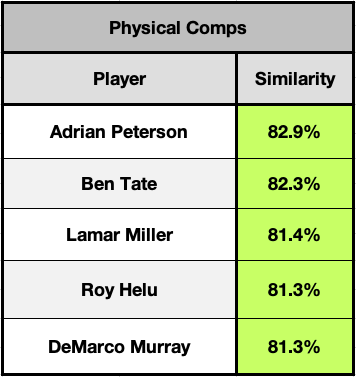
Every single one of these guys has at least one 1000-scrimmage yard NFL season on their resumé. That seems good. Hall certainly fits the physical profile of a guy who should see success as a professional running back.
Production Profile
Breece Hall‘s production might be even more impressive than his superficial athletic qualities:
Removed from his 18th birthday by just three months to the day, Hall was an elite producer on quality teams in a Power 5 conference from the first time he stepped on a college football field.
Given the seasonal Dominator Ratings he posted and the quality of teams he played for, the following historical prospects had the most similar college production profiles:
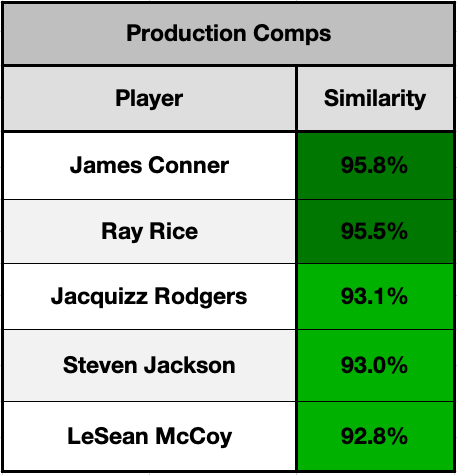
None of the guys on this list played at powerhouse programs. But producing like they did is generally enough to indicate that you can be a quality NFL player. The only runner here without an RB1-level fantasy season on his record is Jacquizz Rodgers; a very talented dude who just happened to be 5-6 and 196-pounds.
Rushing Efficiency
A full breakdown of Breece Hall‘s rushing efficiency profile can be found here, but the following is a quick overview:
It’s become almost blasphemous to even suggest that Hall might not be a perfect prospect. I’m here to do just that.
An underreported feature of his efficiency profile is that he wasn’t particularly consistent relative to his teammates. Success Rate counts how often a player gains a requisite amount of yards on his carries given the down-and-distance situations he is carrying the ball in. Considering the box counts he saw, he was barely better in this area than teammates who were rated in the 44th-percentile as high school recruits.
Despite impressive overall efficiency that is at least somewhat fueled by a very high Breakaway Conversion Rate, that Relative Success Rate mark tells me he might be lacking some nuance to his game as a runner. Maybe he makes poor decisions, or has subpar vision, or dances in the backfield too much. I don’t know because I’m not a skilled film evaluator. But the numbers indicate that he’s not succeeding on an impressive percentage of his carries.
Overall, he’s clearly an effective runner. He breaks tackles at a high rate, is great in the open field, and proved capable of handling heavy volume. I’d bet on him being good in the NFL. But let’s also acknowledge that he’s not infallible.
Pure Runner Comps
Given his physical profile in combination with the above metrics, the most similar historical prospects to Breece Hall from a “pure runner” perspective are:
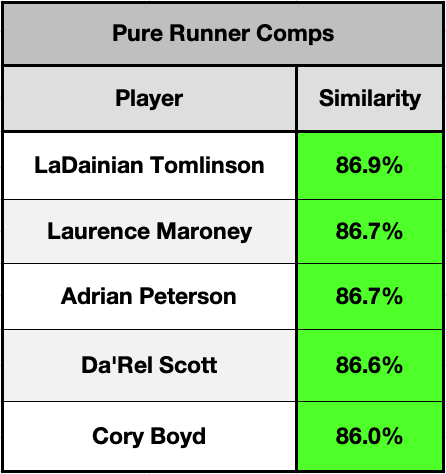
That’s an impressive top-three. But it’s important to point out that among these players, more advanced efficiency data is only available for Da’Rel Scott. I don’t even have Chunk Rate or Breakaway Conversion Rate numbers for the other four guys on this list.
If we were to construct a Pure Runner comps list for Hall using only players for whom I do have that data, it would look like this:
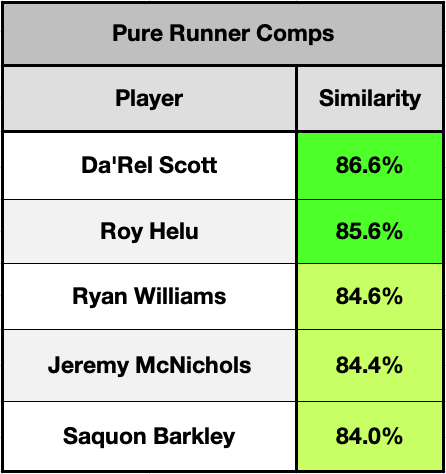
I think this list more appropriately represents the risk associated with Hall’s efficiency numbers. The Jeremy McNichols Corollary says that players with inconsistent per-carry output veiled by athleticism and big play-fueled overall efficiency are risky projections to the NFL.
I rate players on a scale from 0-100 based on how severely their numbers fit that categorization. Hall scores a somewhat-scary 45.4. It’s not a death sentence to end up associated with the McNichols Corollary. But many of the players in his range had a hard time translating their college rushing success to the next level. Keep in mind that every single one of these players had positive overall efficiency numbers in college:
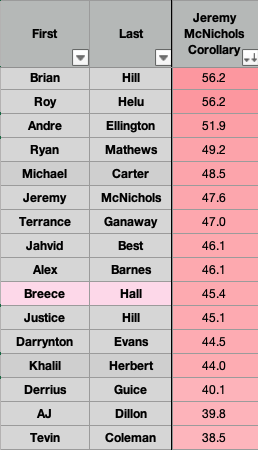
Receiving Chops
Breece Hall completes the athlete-runner-receiver trifecta by having been a prolific pass-catcher at Iowa State:
Or does he?
Hall was certainly prolific in the receiving game. His volume stats and market share numbers are excellent. Oftentimes though, those things are more indicative of a player’s overall talent than they are of his ability as a pure pass-catcher. Jay Ajayi caught 73 balls and had a 90th-percentile Target Share on Boise State teams that were just as good as the Iowa State teams that Hall played on. But nobody is confusing him for a three-down threat. Ajayi wasn’t a great receiver. But he was the best player on those squads, so the Broncos fed him by any means necessary. Both on the ground and through the air.
The same goes for Hall. And his 31st-percentile Satellite Score indicates that his receiving involvement was not actually that great in light of his massive overall share of the team’s offense.
More Context
Better indicators of the kind of receiver we should expect Breece Hall to be in the NFL are his ancillary usage and efficiency metrics. He wasn’t deployed dynamically, being lined up primarily in the backfield and targeted almost exclusively behind the line of scrimmage. His YAC numbers also represent a fairly large chunk of his overall per target and per reception efficiency, indicating that most of his damage as a receiver is actually being done as a ballcarrier. Further, while his Catch Rate is a 74th-percentile mark, his True Catch Rate (which only looks at targets that were catchable) of 88.2-percent is pretty average. It comes in at No. 18 among 38 running backs invited to this year’s Combine. And it lands in the same range as traditional two-down runners like Tyler Allgeier, Kennedy Brooks, and Abram Smith.
Given the above metrics, here are the historical prospects whose receiving profiles most closely resemble Hall’s:
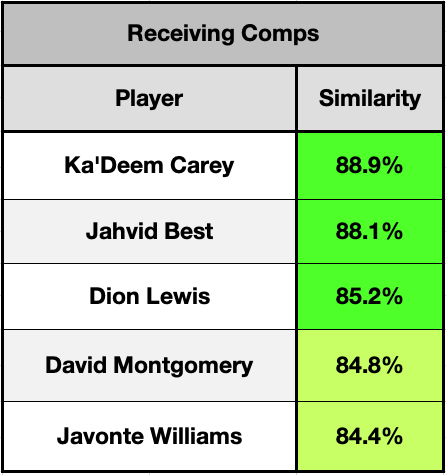
David Montgomery and Javonte Williams are great examples of the kind of receiver we should expect Hall to be at the next level. He’s a pure runner who doesn’t necessarily need to be pulled off the field on third down. But he’s likely not going to be some advanced threat in the passing game.
Overall Profile
Breece Hall checks every box and is easily the RB1 in this class. My issue is that the boxes that he checks emphatically are the most superficial. Athleticism and production are important because they indicate generally who the best players are. But I want my RB1 to pass the micro-level sniff tests to a much greater degree than Hall does. His alignment with the Jeremy McNichols Corollary doesn’t inspire confidence. And neither do his relatively blah contributions as a receiver.
The historical prospects whose complete profiles were most like Hall’s are the following:
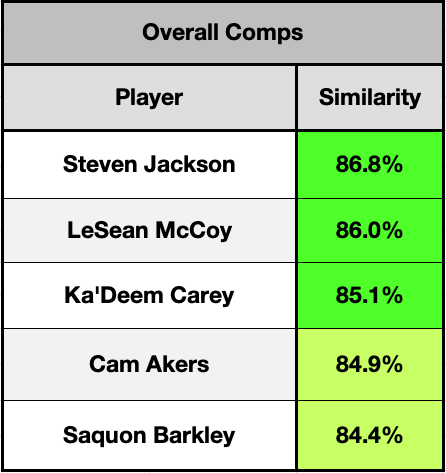
Steven Jackson, LeSean McCoy, and Saquon Barkley have all been elite RB1s in fantasy. And we think Cam Akers is good, so this list is pretty nice. But Barkley himself is a card-carrying member of the McNichols Corollary Club. And criticism that he dances too much in the backfield and isn’t a nuanced, instinctive runner outside the athletic advantages he possesses have mostly rung (rang? ringed?) true in the NFL.
Overall, Hall has a complete profile with no boxes left unchecked and is deserving of his place atop the 2022 running back class. I think I prefer to let somebody else select him at the 1.01 though. And I’m probably trading out for a haul given the coronation he’s already received from the fantasy community at large. He’s talented and he’ll probably be a good fantasy producer. But there’s too much subtle risk for me to fully get on board with him as a no-doubt prospect. I’d rather spread that risk throughout a package return of picks and players.






